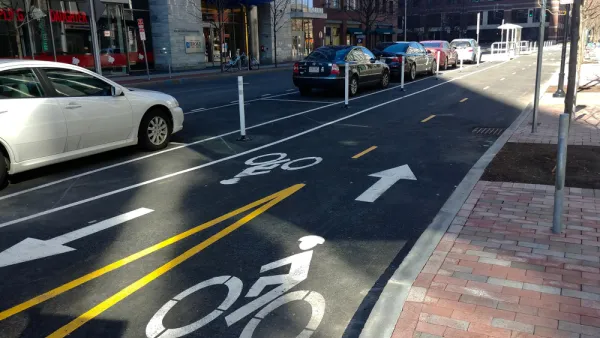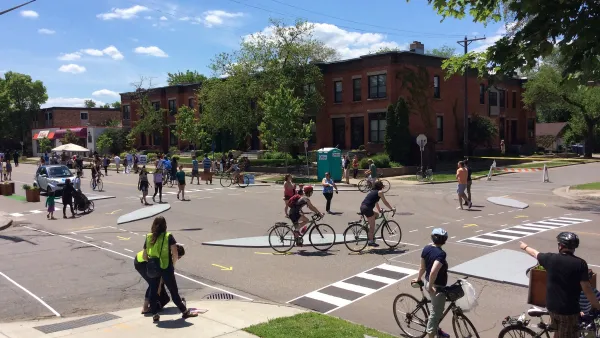Bike boxes, a European import, may not have received as much attention other novel bike facilities such as protected bike lanes, but they are spreading. Nashville's first bike box accompanies a road diet and buffered bike lanes.
"More than 20 cities have painted [bike boxes] at intersections, according to Nashville's Metro Public Works," writes Josh Brown of The Tennessean who accompanied a group of Nashville cyclists in late August to "test the city’s first bike box — a space at an intersection that allows cyclists to cut ahead of traffic and wait in their own specially designated area until the light turns green." [See image].
The boxes are growing in popularity across the country as communities search for ways to reduce accidents between cyclists and motorists and encourage more people to use bicycles to get around.
In fact, according to most studies [PDF], the majority of bike-motor vehicle collisions occur at intersections, so the importance of these boxes can not be overstated from a bike safety perspective.
“There’s a lot of misunderstanding for the rules of the road between bicyclers and motorists,” said Liz Thompson, executive director of Walk/Bike Nashville, a nonprofit that promotes cycling and walking as transportation alternatives. “When there’s a bike lane and bike box that gives you space up ahead, that in general that can reduce a lot of that tension.
The bike box is located on Church Street which has seen major, though controversial street improvements to make it significantly more bike-friendly.
The new box comes about a month after public works made changes to the Church Street bridge that reduced the number of traffic lanes from four to two with a center turning lane. The officials took the extra space to create buffered bicycle lanes on both sides of the street.
The Church Street road diet has come at a cost. Brown writes that auto congestion has increased significantly, and bike usage may not have increased. However, Nora Kern of Walk/Bike Nashville states that "as the population of the city grows, the streets around Nashville’s urban core won’t be able to accommodate a car for every person."
“We have to start now to start planning for the future of Nashville,” [Kern] said. “In five years, if we wait, it’s going to be 100 times harder.”
FULL STORY: New bike box offers cyclists their own spot in traffic

Analysis: Cybertruck Fatality Rate Far Exceeds That of Ford Pinto
The Tesla Cybertruck was recalled seven times last year.

National Parks Layoffs Will Cause Communities to Lose Billions
Thousands of essential park workers were laid off this week, just before the busy spring break season.

Retro-silient?: America’s First “Eco-burb,” The Woodlands Turns 50
A master-planned community north of Houston offers lessons on green infrastructure and resilient design, but falls short of its founder’s lofty affordability and walkability goals.

Test News Post 1
This is a summary

Analysis: Cybertruck Fatality Rate Far Exceeds That of Ford Pinto
The Tesla Cybertruck was recalled seven times last year.

Test News Headline 46
Test for the image on the front page.
Urban Design for Planners 1: Software Tools
This six-course series explores essential urban design concepts using open source software and equips planners with the tools they need to participate fully in the urban design process.
Planning for Universal Design
Learn the tools for implementing Universal Design in planning regulations.
EMC Planning Group, Inc.
Planetizen
Planetizen
Mpact (formerly Rail~Volution)
Great Falls Development Authority, Inc.
HUDs Office of Policy Development and Research
NYU Wagner Graduate School of Public Service




























